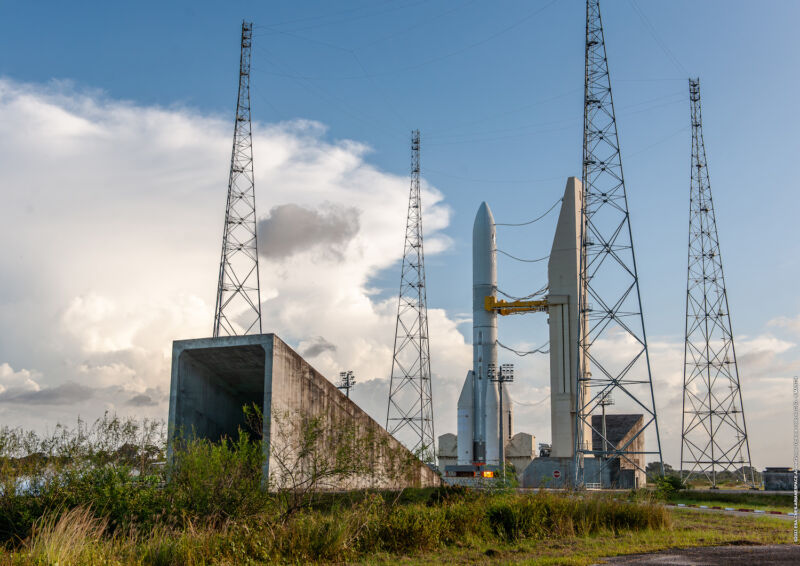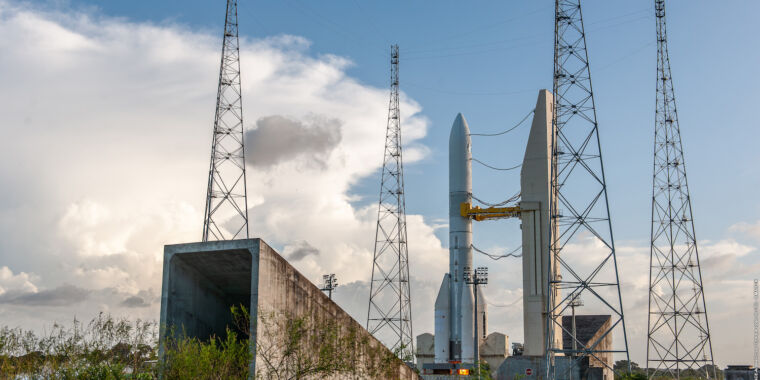
Last month, a full-scale test model of Europe’s Ariane 6 was put to the test on its launch pad in the jungles of French Guiana. For the first time, the launch team at the tropical spaceport loaded cryogenic liquid hydrogen and liquid oxygen into the Ariane 6 over the course of a marathon 26-hour test campaign.
But it took a week for the European Space Agency, which is funding the 3.8 billion euro ($4.1 billion) development of Ariane 6, to release an update on the test. It turned out the launch team could not accomplish one of the main goals of the countdown rehearsal: A brief four-second ignition of the Ariane 6’s main engine.
An ESA spokesperson described the test on July 18 as “very satisfactory” even though the engine didn’t light. It’s true that the simulated countdown checked off some key objectives. The launch team in French Guiana—consisting of membership from ESA, prime contractor ArianeGroup, and the French space agency CNES—supervised the loading of more than a half-million liters of liquid hydrogen and liquid oxygen into the 207-foot-tall (63-meter) Ariane 6.
“During the 26-hour exercise, the teams successfully tested many degraded and contingency modes, demonstrating that the launcher and the launch base fit correctly,” ESA said. “Operational procedures, lower and upper stages, avionics, software, launch base, and control bench worked correctly together, and the performance of the full launch system was measured with excellent results.”
The countdown test on July 18 proceeded up to the time that the Ariane 6’s Vulcain 2.1 main engine would have ignited during a real launch attempt. Going into the test, officials planned to fire the engine for approximately four seconds while the Ariane 6 remained on the pad. Managers called off that objective because time ran out, ESA said, without offering additional detail.
The Ariane 6 countdown test originally started July 13, but the countdown that day was cut short before the test continued five days later. ESA didn’t mention that in their press release discussing the outcome of the countdown rehearsal.
You won’t get to watch the Ariane 6 hot-fire test
An ESA spokesperson told Ars that engineers are considering whether to mount another countdown rehearsal to complete the four-second engine-firing milestone or to go directly to a follow-up simulated countdown that was already planned for September. That one will culminate in a longer Vulcain 2.1 engine firing that could last up to 500 seconds, approximating the duration of a main engine burn during launch.
The space agency’s spokesperson said ESA is not planning to provide live video of the long-duration Ariane 6 test-firing in French Guiana. That’s disappointing and would be a missed opportunity for ESA to engage with the taxpayers footing the bill for this new rocket.
Other entities like ArianeGroup and the French space agency occupy the launch control center consoles for the Ariane 6 testing. ESA not only controls the purse strings but also has the final say in releasing updates on the Ariane 6 program.
ESA’s decision not to broadcast live video of the Ariane 6 hold-down test-firing easily contrasts with NASA, which provided live coverage of two hot-fire tests for its Space Launch System rocket in 2021. Like the Ariane 6, NASA’s SLS Moon rocket is a publicly funded venture.
Other companies also have livestreamed test firings of their high-profile rockets. SpaceX provided live video of a multi-engine test-firing of its Super Heavy booster earlier this year before it launched on SpaceX’s first full-size Starship test flight. In June, United Launch Alliance produced a live webcast for a six-second engine firing of its new Vulcan rocket.

